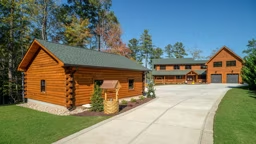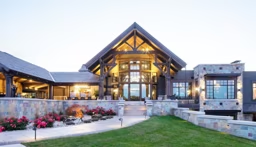
Are you one of those people who are thinking about building a log home because you like the way they look and feel, buy have heard that they’re a lot of work to maintain? You’re not alone. Since our lives have become so fast paced, with every moment of every day accounted for, there’s little time left to spend on home maintenance. Besides that, who wants to work hard on their house? You want to enjoy the log home life, right? Well, you can build a wonderful log home with all the charm, character and warmth, but little or no maintenance.
Ok, let’s begin with the truth. There is no such thing as a maintenance-free anything when it comes to housing. Any house, no matter if it’s log, timber, concrete or stick frame, requires some level of maintenance to keep it looking and performing its best. However, with a few tricks and tweaks, and proper use of the new materials on the market, you can build and enjoy a beautiful log home that requires so little upkeep, it will feel like it’s maintenance free. In fact, over time, I have needed to do more maintenance on my brick home in Nashville than I have on my log home in the country, but to reinforce my own experience, I have turned to some of the experts in the industry for their insight about how to build a durable log home.
Maintenance-Free Fundamentals
If building a low/no-maintenance log home is possible, then why have some log home owners complained about their log home to-do lists?As a wood stain-and-sealant professional, I have visited hundreds of log homes in my career. I have seen 150-year-old structures in wonderful condition and 10-year-old houses that need a lot of work. What is the difference? The most important aspect is simply design.
Wood is a natural and beautiful material, but its innate tendency is to return to the earth from which it came the moment it “dies.” So when we fell trees to use in log homes, we’re going against the grain, so to speak, because we seek to stop this cycle in its tracks. With proper design, wood walls and other architectural aspects of the home can be protected. Deep roof overhangs and porches will shield the logs from rain, and proper siting to avoid the afternoon sun, combined with mature trees that will filter the UV rays, can protect your home from the harmful effects of Mother Nature.
The fact is that wood that’s kept dry, is properly finished from the onset and is protected from the sun can last many years with no maintenance.
My log home in Tennessee is 24 years old and I have re-stained one side of it in that time — so I know it can be done, and one of the simplest (and most attractive) ways to accomplish this is with a porch.
Sam Satterwhite of Satterwhite Log Homes told me, “Son, we build our homes in Texas where if it’s not raining, the sun is beating down; and if the sun isn’t out, it might be blowing a cold blue norther in. I wouldn’t build a house here without a porch all the way around it – or at least on three sides.”
Material Advantages
The second aspect to building a maintenance-free log home is to incorporate new, manmade materials and use them alongside your logs. They look like wood, but they need less maintenance.Why would you want to put “fake” wood next to the real thing? The design of many log homes necessitates that some features be exposed to the elements. Dormers, for instance, are above the roofline and are unshielded against the sun and rain. There are many substitutes that can be used to keep the rustic look of logs, but without the wood. Zach Parmeter of Wisconsin-based Golden Eagle Log Homes has several good ideas about how to use these newer materials.
“You can eliminate the maintenance of the hard-to-reach areas of your home. We like to do the gable ends in a maintenance-free product such as vinyl shakes, corrugated or flat-panel weathered steel. All these options look great and never need painting or staining. Plus, there are many colors and varieties to choose from,” Zach says. This is a great way to eliminate maintenance not only the most vulnerable parts of the home, but also the most expensive because these challenging areas cost more to care for.
“Maintenance-free genuine or cultured stone is another way to reduce exterior maintenance and still maintain a rustic look,” according to Zach. “We often change wooden deck floors to stamped concrete or composite planking, as these materials don’t require maintenance.” Zach also recommends windows that are clad in aluminum or polymer to reduce or eliminate their upkeep.
Common Mistakes (and How to Avoid Them)
One of the most common mistakes I have seen is when builders place wooden post bases in direct contact with a porch, deck or masonry. Each time the deck or masonry becomes wet, water will soak into the ends of the posts. Capillary attraction then draws the moisture into and up the posts, which causes rot and results in expensive repairs. The simple use of a plinth made of a material that won’t rot will prevent this problem forever.Another big and dangerous misstep is wood handrails on decks. Handrails are there for one purpose — to protect you, your family and your guests from falling. Handrails that aren’t covered by a roof should be built from rot-proof or manmade materials. Wood that’s exposed to the elements will eventually need maintenance and should not be used if you wish to build a home with zero — or close to zero — upkeep.
I hope these tips will help to relax your fears about log home maintenance. My brothers and I built our family’s log retreat ourselves more than two decades ago, and we have never regretted it for a second. We have watched our parents grow older there, and our children have grown up there. The experiences and wonderful times we’ve had in that house are irreplaceable. They are an integral part of our family’s heritage. I sincerely hope you can experience that the same feeling one day. Owning a log home is a unique and rewarding experience. I wouldn’t trade it for the world.
Paul Peebles has been in the log home business since 1993. He has built new log homes, relocated antique log homes, sold log homes and advised hundreds of people on how to repair, restore and maintain their homes. He currently sells log home stains, sealants, chinking, and preservatives for Perma-Chink Systems, Inc.











